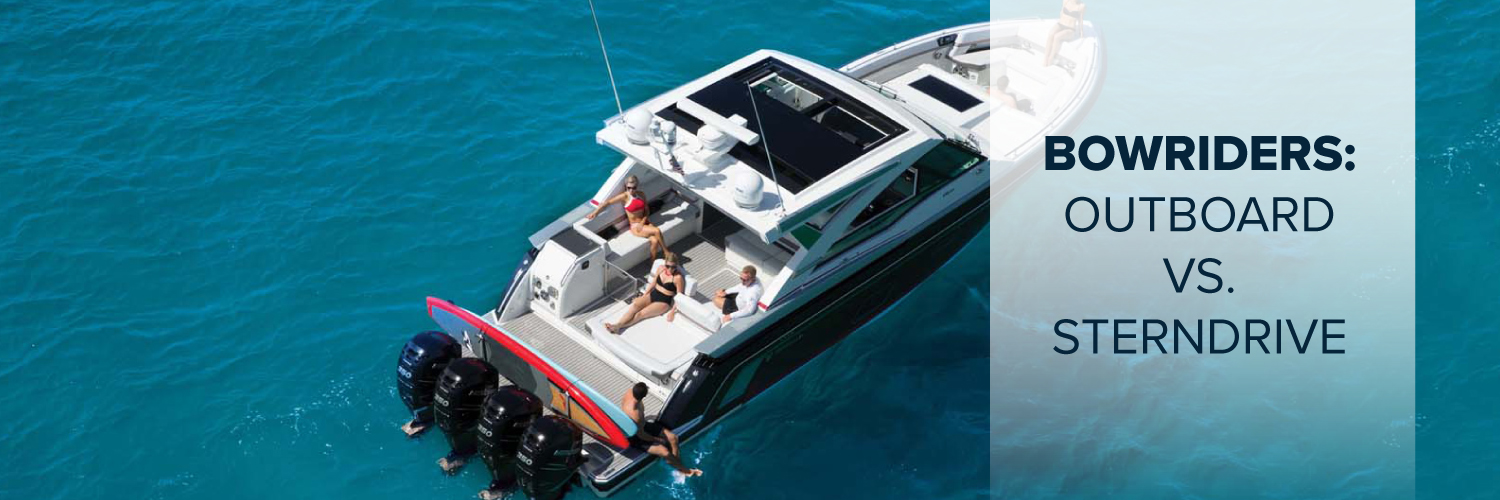
If you’re in the market for a bowrider boat, chances are you’ve noticed more and more are available with outboard engines in place of sterndrive engines. In the past, sterndrives have always been the preference for bowriders, but as time has gone on brand new boats are coming with outboard power, even when it comes to some high-performance boats. According to Statistical Surveys Inc. (SSI), the US Boat industry has sold more and more outboard-powered boats over the past few years — up from 127,981 in 2012 to 165,435 in 2016.
What is the reason behind this industry shift to outboards? How do you know if an outboard engine is right for you? What features do you need to consider as you shop for your bowrider? We’ve compiled a list of some of the critical factors to consider — performance, fuel efficiency, space, aesthetics, tilt, cost, maintenance, winterization and noise level. While outboard engines outperform sterndrive engines in some areas and vice versa, the decision ultimately comes down to your specific boating wants and needs.
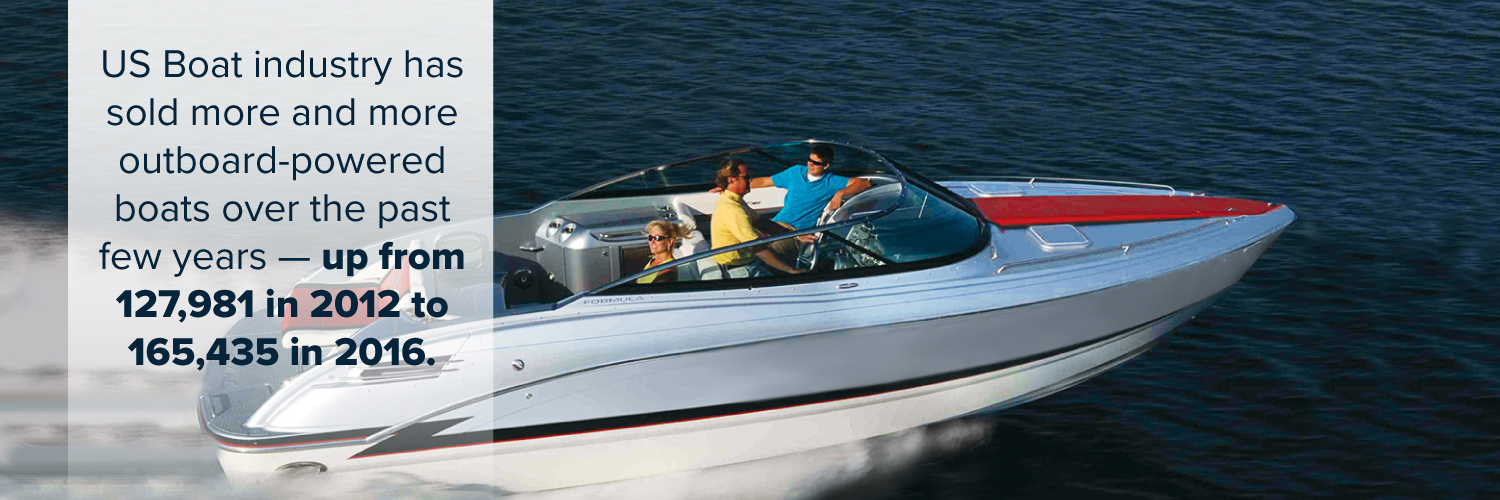
Types of Engines
Before we get into the specifics of each factor, it’s important to be familiar with the three types of boat engines — inboard, outboard and sterndrive, also known as inboard/outboard. The main difference between the three is the location of the engine.
INBOARD ENGINES
Inboard engines are under the deck and out of sight. There are two types of inboard engines, D-Drive and V-Drive. D-Drives go in the center of the boat, with the prop and rudder beneath the hull. V-Drive engines maintain the same location for both the prop and rudder, but the engine itself is under the transom seating.
Often the choice of D-Drive versus V-Drive comes down to the use of the boat. D-Drive’s location in the center of the boat results in a much smaller wake, making it ideal for ski boats. The position of the V-Drive naturally causes a more significant wake and is perfect for other watersports.
OUTBOARD ENGINES
As their name suggests, outboard engines are attached high on the transom, outside of the boat. This engine location is visible and accessible, so it can be tilted out of the water, making maintenance a breeze. These engines are also known for their steering ease. While outboard engines are usually less powerful than inboards, you can match the power by having a few outboards on your boat.
STERNDRIVE ENGINES
Sterndrive engines, also known as inboard/outboards (I/O), are a combination of inboard and outboard engines, as their name suggests. In sterndrive engines, the motor is in the back of the boat under the transom. The drive unit is tucked beneath the swim deck.
Outboard vs. Sterndrive on Bowriders
If you’re interested in purchasing a recreational boat, you’re probably considering a bowrider. The two most popular engines for bowriders are sterndrive and outboard engines. There are several factors to comparing these two types of engines, and both engines come with their list of pros and cons. We’ve gathered information regarding several of the key factors to consider when you’re deciding on outboard vs. sterndrive on bowriders below.
PERFORMANCE
When it comes to the performance of outboards vs. sterndrives, you want to consider the power-to-weight ratio. Outboards weren’t always able to compete in the performance category, but the amount of horsepower you can pack into them today is a game changer. Both sterndrives and outboards will come with a choice of horsepower, but there are other important aspects to consider.
For example, if we’re comparing a 200-horsepower sterndrive to a 200-horsepower outboard — both have the same horsepower, but one weighs significantly more than the other. The difference in weight varies depending on the specific model of each, but an outboard is frequently hundreds of pounds lighter. Usually, when it comes to performance and overall handling, lighter is better. However, it is important to consider what type of water you’ll cruise, as more weight gives you a much sturdier ride as you cut through waves.
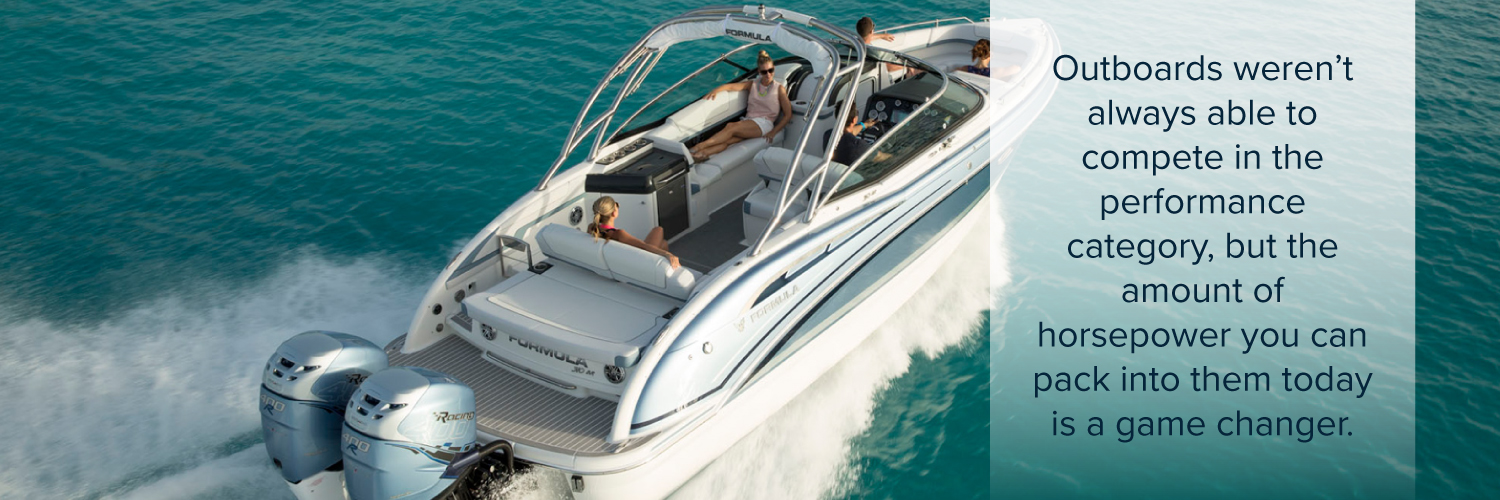
FUEL EFFICIENCY
Those hundreds of pounds you save in weight with an outboard translate to savings when it comes to fuel efficiency. If gallons per hour are important to you, consider a modern four-stroke outboard, as they are often the most fuel efficient. While RPMs at a cruising speed tend to be higher with an outboard engine, they still beat sterndrives in fuel efficiency — one of the pros of outboards on bowriders.
When thinking about saving fuel, be sure to estimate how often you’ll be using your boat. More frequent use means the savings due to fuel efficiency may add up, but if you aren’t anticipating frequent rides, you may place less of an emphasis on this factor.
SPACE
Whether you choose an outboard or a sterndrive for your bowrider, you’re going to have to sacrifice space — it’s just a matter of how much and where.
With a sterndrive underneath the boat, you’re able to maintain a full swim platform on the back, uninterrupted by an outboard. If you’re primarily going to be using your boat for hosting family and friends and want to have that easy access to the water, this is something to consider. On the flip side, if you choose an outboard motor, you’ll lose space on the back but gain a bit of cockpit space for storage or seating usage. It all depends on the specific bowrider model.
AESTHETICS
Functional space is one thing to consider — style and aesthetics are another. While these two areas go hand-in-hand, your preference is the ultimate decision-maker. Sterndrive engines are often the aesthetic choice because they’re entirely out of view. However, some prefer the look of an outboard engine on the back of a bowrider. It’s all about personal preference.
TILT
There’s only one option when it comes to tilt — outboard. Sterndrive engines cannot tilt, given their location underneath the boat and out of sight. With an outboard engine, you can shift the whole engine, prop and drive entirely out of the water. This is one of the pros of outboards on bowriders.
First of all, it enables you to navigate through shallow waters. Second, by tilting your outboard motor up when you’re not using it, you dramatically decrease exposure to marine growth and corrosion from salt water. Finally, outboard tilt allows you to drain all the water out of the engine, protecting it from the risk of an unexpected overnight freeze. With a sterndrive engine, you don’t have this option, as the engine isn’t as accessible.
COST
Outboards and sterndrives have a completely different design, which means their upfront price tags are different. Pricing between the two used to be more competitive, but now outboards are almost always less up-front. In 2010, the Environmental Protection Agency (EPA) mandated that all sterndrives needed to use catalytic converters, just like car engines. The addition of catalytic converters caused the price of sterndrives to increase, while the outboard motor was able to maintain its cost.
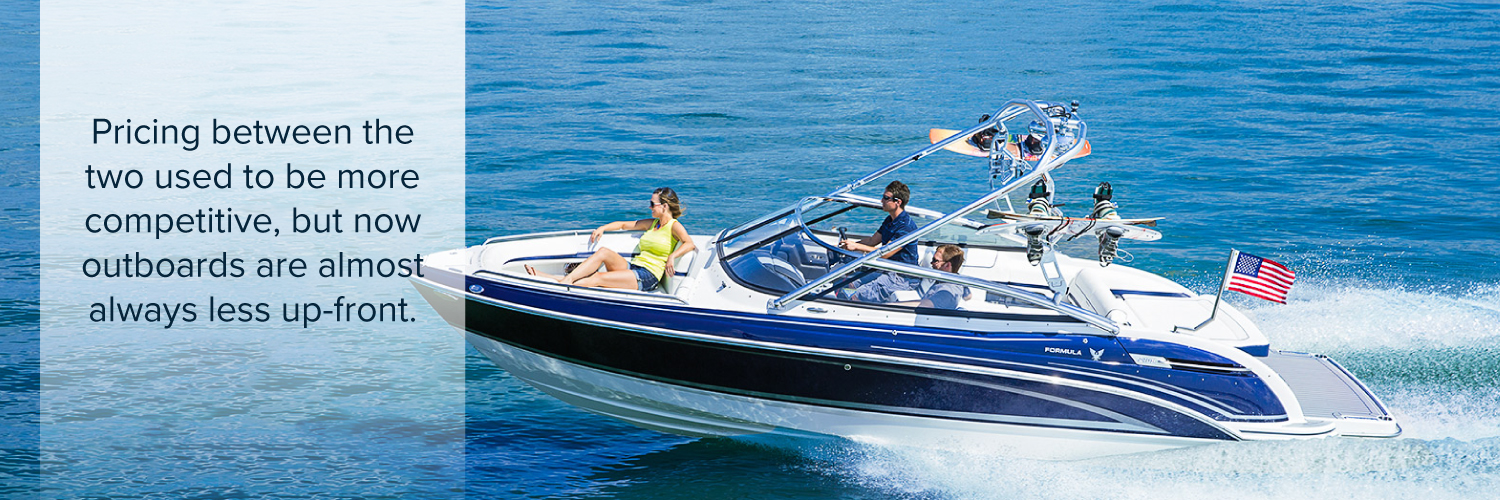
MAINTENANCE
In addition to considering up-front cost, it’s also important to think about the price of maintenance and what it will entail for each type of engine. While it’s impossible to predict the specific repairs your engine may need, there are a few things worth noting. First of all, neither engine requires more routine maintenance than the other. When repairs are necessary, however, sterndrives are usually more expensive to fix.
As previously mentioned, a sterndrive engine isn’t as easy to access in the back of the boat. Difficult access means more expensive labor costs when routine maintenance or repairs are needed. Outboard engines, on the other hand, are outside the boat, making them easier to reach for repairs and giving you the ability to conduct most maintenance in or out of the water. Outboard engines are also much more DIY-friendly.
WINTERIZATION
Sterndrive engines use a marinized automotive engine block, making them much more sensitive to the cold. Because of this, they require a more extensive winterization process, and you’ll want to avoid any risk of freezing. Both of these factors may mean a shorter boating season.
Winterizing a sterndrive engine is usually done by a qualified marine mechanic because it’s a complicated operation. That means more prep to get your boat ready in the spring. In addition to extra winterization time, sterndrive engines must avoid freezing temperatures to prevent extensive damage, which can mean cold nights force you to take your boat out earlier than you’d like.
Overall, outboard engines have a much more straightforward winterization process, which is a pro that can mean a DIY winterization for many owners. Simple winterization means you’re up and running in no time in the spring. Don’t forget the tilt, which drains the water and makes your outboard engine much less susceptible to freezing — allowing you to extend the boating season for as long as possible.
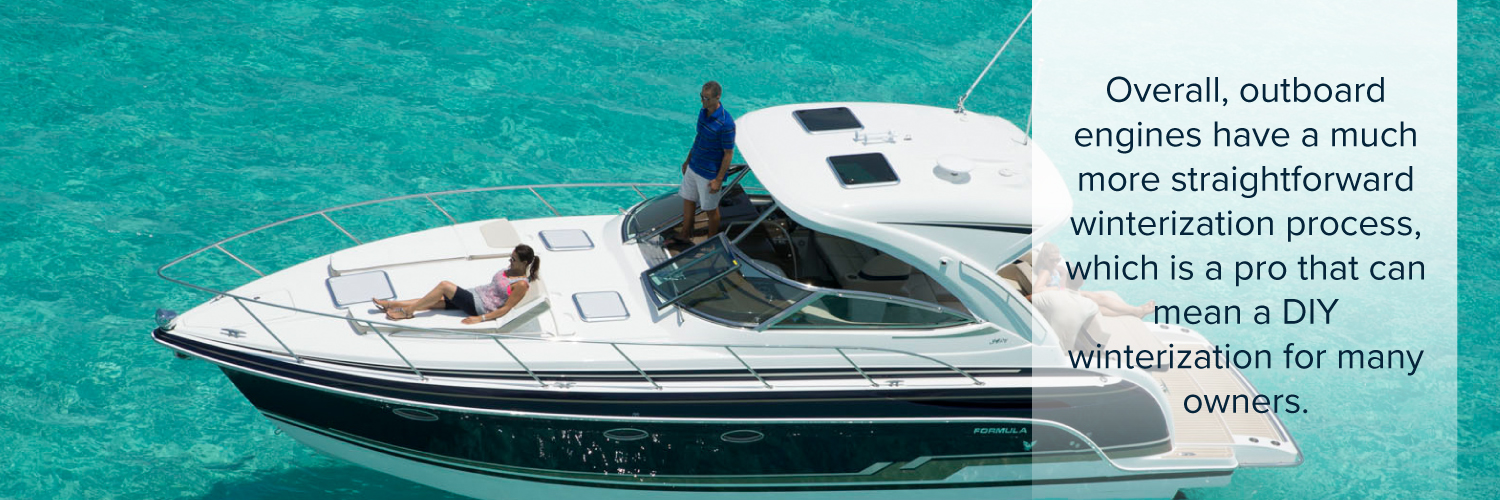
NOISE LEVEL
When it comes to sound, sterndrive engines used to have an edge on outboards because of their location underneath the bowrider, whereas the outboard is open to exposure in the back of the boat. However, the newer four-stroke outboards have significantly improved in noise level. While sound is always something to consider, especially if you’re hoping to host family and friends on your new boat, we’re pretty confident you’ll find that modern-day outboards and sterndrives are pretty even in this category.
Outboard vs. Sterndrive Pros and Cons
Over the past several years, it’s clear that outboards have come a long way in many respects, making the market much more competitive when it comes to choosing between outboards vs. sterndrives on bowriders. However, in the end, the right choice relies upon your specific boating wants and needs.
While all of these factors — performance, fuel efficiency, space, aesthetics, tilt, cost, maintenance, winterization and noise level — are important to consider in your decision, the pros and cons are subject to your situation. For example, while the lighter weight of the outboard may make a great solution for someone who wants a boat to take around a lake, it could also be a nightmare for someone who is looking to navigate the rough waves of the ocean.
Formula Boats: Outboard and Sterndrive on Bowriders
At Formula Boats, we understand that it’s important to be able to customize your new bowrider boat with an outboard or sterndrive engine based on your needs. That’s why we offer our customers a choice between the motors. In addition to flexibility in engines, our boats have a variety of other customizable features, especially when it comes to our bowriders.
We offer six different bowrider models, plus two crossover bowrider models that feature an enclosed cabin. Each comes with standard features and additional options to personalize your boating adventure. Our models range from 24 to 35 feet in length, with max beams ranging from eight feet six inches to ten feet nine inches. Each model comes with plenty of storage for everything from watersport accessories to food and drinks, and our adjustable seating makes it easy to rearrange seats and backrests to accommodate any crew.
Two of our bowriders are also available in an Extreme Sport (XS) model, with a forward-facing sterndrive engine, which is yet another custom engine option that’s of particular interest to watersports enthusiasts. This specific sterndrive engine is beneath the hull of the boat, moving the props below and away from the rider, similar to an inboard prop. It also pushes exhaust out into the water rather than into the air behind the boat and in your face.
There is certainly a lot to consider when you’re in the market for a new boat. You can begin building your custom boat on our website. Choose everything from the specific type of outboard or sterndrive engine to the exterior color. You’ll get an immediate price based on the model you’ve built and access to discounts our dealers may be offering. If you aren’t sure exactly what you need or have more specific questions regarding outboard and sterndrive engines, please contact us — we’d love to help you find the boat solution that’s best for you.
